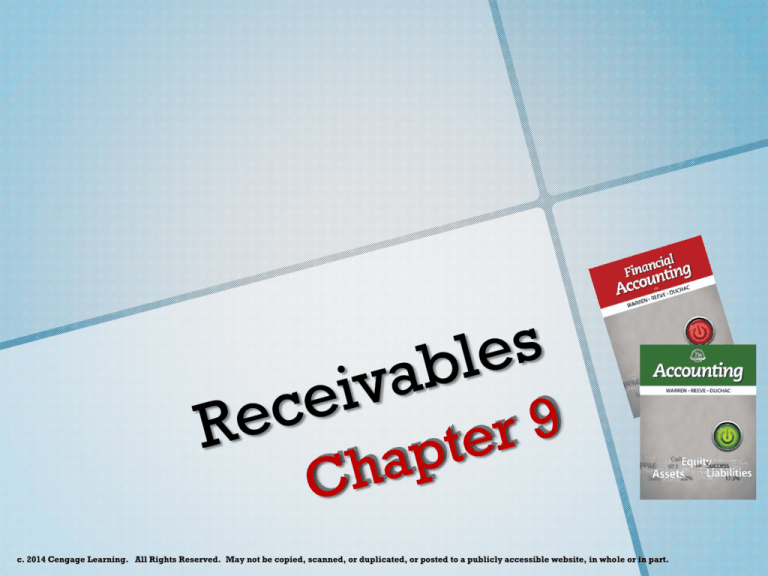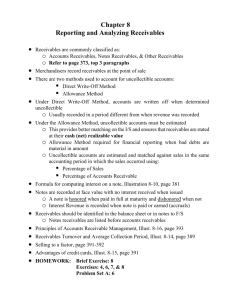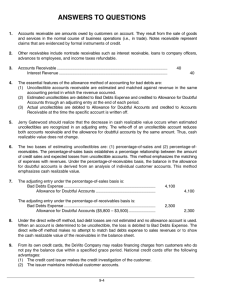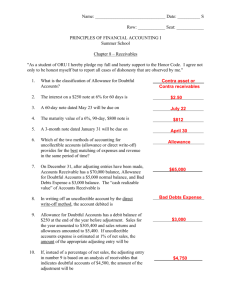
c. 2014 Cengage Learning. All Rights Reserved. May not be copied, scanned, or duplicated, or posted to a publicly accessible website, in whole or in part.
Learning Objectives
1.Describe the common classes of receivables.
2.Describe the accounting for uncollectible
receivables.
3.Describe the direct write-off method of
accounting for uncollectible receivables.
4.Describe the allowance method of accounting
for uncollectible receivables.
5.Compare the direct write-off and allowance
methods of accounting for uncollectible
accounts.
Learning Objectives
6.
7.
Describe the accounting for notes receivable.
8.
Describe and illustrate the use of accounts
receivable turnover and number of days’ sales
in receivables to evaluate a company’s
efficiency in collecting its receivables.
Describe the reporting of receivables on the
balance sheet.
c. 2014 Cengage Learning. All Rights Reserved. May not be copied, scanned, or duplicated, or posted to a publicly accessible website, in whole or in part.
Classification of Receivables
o Accounts receivable are normally expected to
be collected within a relatively short period,
such as 30 or 60 days.
Classification of Receivables
o Notes receivable are amounts that customers
owe for which a formal, written instrument of
credit has been issued.
Classification of Receivables
o Other receivables expected to be collected
within one year are classified as current assets.
If collection is expected beyond one year,
these receivables are classified as noncurrent
assets and reported under the caption
Investments. Examples of other receivables
include:
Interest receivable
Taxes receivable
Receivables from officers or employees
c. 2014 Cengage Learning. All Rights Reserved. May not be copied, scanned, or duplicated, or posted to a publicly accessible website, in whole or in part.
Uncollectible Receivables
o Companies often sell their receivables to other
companies. This is called factoring the
receivables, and the buyer of the receivables is
called a factor.
Uncollectible Receivables
o Regardless of how careful a company is in
granting credit, some credit sales will be
uncollectible. The operating expense recorded
from uncollectible receivables is called bad
debt expense, uncollectible accounts expense,
or doubtful accounts expense.
Uncollectible Receivables
o Some indications that an account may be
uncollectible include the following:
The receivable is past due.
The customer does not respond to the company’s
attempts to collect.
The customer files for bankruptcy.
The customer closes its business.
The company cannot locate the customer.
Uncollectible Receivables
o The direct write-off method of accounting for
uncollectible receivables records bad debt
expense only when an account is determined
to be worthless. The allowance method records
bad debt expense by estimating uncollectible
accounts at the end of the accounting period.
c. 2014 Cengage Learning. All Rights Reserved. May not be copied, scanned, or duplicated, or posted to a publicly accessible website, in whole or in part.
Direct Write-Off Method
o On May 10, a $4,200 account receivable from D.
L. Ross has been determined to be
uncollectible.
Direct Write-Off Method
o The account written off on May 10 is later
collected on November 21.
Reinstatement
entry
Receipt of
cash entry
c. 2014 Cengage Learning. All Rights Reserved. May not be copied, scanned, or duplicated, or posted to a publicly accessible website, in whole or in part.
The Allowance Method
o On December 31, ExTone Company estimates
that a total of $30,000 of the $200,000 balance
of their accounts receivable will eventually be
uncollectible.
The specific customer accounts
cannot be decreased, so a contra
account, Allowance for Doubtful
Accounts, is credited.
The Allowance Method
o The net amount that is expected to be
collected, $170,000 ($200,000 – $30,000), is
called the net realizable value (NRV) of the
receivables. The adjusting entry reduces
receivables to the NRV and matches
uncollectible expenses with revenues.
The Allowance Method
o On January 21, John Parker’s account of $6,000
is written off because it is uncollectible.
Note that the allowance
account credited earlier is
debited at the write-off, not
Bad Debt Expense.
THE ALLOWANCE
METHOD
The Allowance Method
o During 2014, ExTone Company writes off
$26,750 of uncollectible accounts, including
the $6,000 account of John Parker. After posting
all entries to write off uncollectible amounts,
Allowance for Doubtful Accounts will have a
credit balance of $3,250 ($30,000 – $26,750).
The Allowance Method
o If ExTone Company had written off $32,100 in
accounts receivable during 2014, Allowance
for Doubtful Accounts would have a debit
balance of $2,100.
The Allowance Method
o Nancy Smith’s account of $5,000, which was
written off on April 2, is later collected on June
10. Two entries are needed: one to reinstate
Nancy Smith’s account and a second to record
receipt of the cash.
Reinstatement
entry
Receipt of
cash entry
Estimating Uncollectibles
o The allowance method requires an estimate of
uncollectible accounts at the end of the period.
Two methods are used to estimate the amount
debited to Bad Debt Expense.
Percent of sales method
Analysis of receivables method
Percent of Sales Method
o If ExTone Company’s credit sales for the
period are $3,000,000 and it is estimated that
3/4% will be uncollectible, Bad Debt Expense
is debited for $22,500 ($3,000,000 x .0075).
This approach disregards the balance of
$3,250 in the allowance account before the
adjustment.
Percent of Sales Method
o After the following adjusting entry on
December 31 is posted, Allowance for
Doubtful Accounts will have a balance of
$25,750 ($3,250 + $22,500).
PERCENT OF SALES
METHOD
Analysis of Receivables Method
o The longer an account receivable is
outstanding, the less likely it is that it will be
collected. Basing the estimate of uncollectible
accounts on how long specific amounts have
been outstanding is called aging the
receivables.
Analysis of Receivables Method
o The analysis of receivables method is applied
as follows:
Step 1: The due date of each account receivable
is determined.
Step 2: The number of days each account is past
due is determined.
Step 3: Each account is placed in an aged class
according to its days past due.
Step 4: The totals for each aged class are
determined.
Analysis of Receivables Method
Step 5: The total for each aged class is multiplied by
an estimated percentage of uncollectible accounts
for that class.
Step 6: The estimated total of uncollectible
accounts is determined as the sum of the
uncollectible accounts for each aged class.
Analysis of Receivables Method
o The preceding steps are summarized in an
aging schedule, and this overall process is
called aging the receivables.
ANALYSIS OF
RECEIVABLES
METHOD
Analysis of Receivables Method
o The estimate based on the age of receivables
is compared to the balance in the allowance
account to determine the amount of the
adjusting entry.
Analysis of Receivables Method
o ExTone Company has an unadjusted credit
balance of $3,250 in Allowance for Doubtful
Accounts. In Exhibit 1, the estimated
uncollectible accounts totaled $26,490. The
amount to be added to the allowance account
is $23,240 ($26,490 – $3,250). The adjusting
entry is as follows:
Analysis of Receivables Method
o After the preceding adjusting entry is posted
to the ledger, ExTone Company’s Allowance
for Doubtful Accounts will have an adjusted
balance of $26,490. This is the amount that was
determined by aging the accounts.
Same amount as the estimated amount
determined by the aging process.
Analysis of Receivables Method
o If ExTone Company’s unadjusted balance of
the allowance account had been a debit
balance of $2,100, the amount of the
adjustment would have been $28,590 ($26,490
+ $2,100).
COMPARING
ESTIMATION
METHODS
c. 2014 Cengage Learning. All Rights Reserved. May not be copied, scanned, or duplicated, or posted to a publicly accessible website, in whole or in part.
Comparing Methods
o The primary differences between the direct
write-off and allowance methods are
summarized below.
c. 2014 Cengage Learning. All Rights Reserved. May not be copied, scanned, or duplicated, or posted to a publicly accessible website, in whole or in part.
Characteristics of Notes Receivable
o A note receivable, or promissory note, is a
written document containing a promise to pay.
Characteristics of a promissory note are as
follows:
The maker is the party making the promise to
pay.
The payee is the party to whom the note is
payable.
The face amount is the amount the note is
written for on its face.
(continued)
Characteristics of Notes Receivable
The issuance date is the date a note is issued.
The due date or maturity date is the date the note is
to be paid.
The term of a note is the amount of time between the
issuance and due dates.
The interest rate is the rate of interest that must be
paid on the face amount for the term of the note.
NOTES RECEIVABLE
Notes Receivable
o The maturity value is the amount that must be
paid at the due date of the note, which is the
sum of the face amount and the interest.
Due Date of a 90-day Note
o What is the due date of a 90-day note dated
March 16?
Days in March
31
Minus issuance date of note
16
Days remaining in March
15
Add days in April
30
Add days in May
31
Add days in June
(due date of June 14)
Term of note
90
days
14
90 days
Alternate Approach
o Total days in note
Number of days in March
Issue date of note, March 16
90 days
31
(16)
Remaining days in March
days
15
Number of days in April
30
Number of days in May
days
31
Residual days in June
Answer: June 14
(14) days
DUE DATE OF A 90DAY NOTE
Accounting for Notes Receivable
o Received a $6,000, 12%, 30-day note dated
November 21, 2014, in settlement of the
account of W. A. Bunn Company.
Accounting for Notes Receivable
o On December 21, when the note matures, the
firm receives $6,060 from W. A. Bunn Company
($6,000 face amount plus $60 interest).
Accounting for Notes Receivable
o If W. A. Bunn Company fails to pay the note on
the due date, it is considered a dishonored
note receivable. The note and interest are
transferred back to the customer’s account
receivable.
Accounting for Notes Receivable
o A 90-day, 12% note dated December 1, 2014, is
received from Crawford Company to settle its
account, which has a balance of $4,000.
Accounting for Notes Receivable
o Assuming that the accounting period ends on
December 31, an adjusting entry is required to
record the accrued interest of $40 ($4,000 x
0.12 x 30/360).
Accounting for Notes Receivable
o On March 1, 2015, $4,120 is received for the
note ($4,000) and interest ($120).
c. 2014 Cengage Learning. All Rights Reserved. May not be copied, scanned, or duplicated, or posted to a publicly accessible website, in whole or in part.
REPORTING
RECEIVABLES ON
THE BALANCE SHEET
c. 2014 Cengage Learning. All Rights Reserved. May not be copied, scanned, or duplicated, or posted to a publicly accessible website, in whole or in part.
Accounts Receivable Turnover
o The accounts receivable turnover measures
how frequently during the year the accounts
receivable are being converted to cash.
Accounts
Receivable
Turnover
=
Net Sales
Average Accounts
Receivable
ACCOUNTS RECEIVABLE TURNOVER
Number of Days Sales in Receivables
o The number of days’ sales in receivables is an
estimate of the length of time the accounts
receivable have been outstanding.
Number of Days’
Average Accounts Receivable
Sales in =
Average Daily Sales
Receivables
NUMBER OF DAYS SALES IN RECEIVABLES
c. 2014 Cengage Learning. All Rights Reserved. May not be copied, scanned, or duplicated, or posted to a publicly accessible website, in whole or in part.








